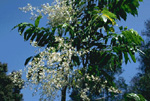 |
Akania lucens, the only species in this family, is endemic to coastal
rainforests of the MacPherson-Macleay region of south-eastern Queensland
and north-eastern New South Wales.
Characteristic features of the family Akaniaceae in Australia include: - trees, with large, prickly-toothed, pinnate leaves
- flowers small, regular, with 5 sepals and petals and usually 8 stamens
- superior, 3-carpellate ovary with a single style and 3-lobed stigma
- ovary superior, developing into a dull red, pear-shaped capsule
Description
Evergreen trees. Internal secretions not obvious. Plants glabrous or bristly. Leaves alternate and spiral, petiolate. Stipules distinct and free from petiole, bristle-like, falling off early; stipellae absent. Lamina once compound, imparipinnate; leaflets symmetric, filiform, acicular, subulate, linear, lanceolate or ovate; base cuneate or rounded; margins serrate or spiny; venation pinnate, with the midrib conspicuous, and the tertiary venation reticulate; surfaces dark- or pellucid-punctate or not punctate; leathery; distinctive odour absent or foetid. Plants with all the flowers bisexual. Inflorescences axillary; paniculate. Bracts present. Flowers fragrant; stalked. Perianth regular, of 2 dissimilar whorls, imbricate in bud. Calyx segments fused, with 5 lobes; calyx bell-shaped, herbaceous. Corolla segments free, with 5 segments, alternating with the calyx lobes; corolla bell-shaped, white or pink, membranous; lobes ±entire. Fertile stamens 8–10, opposite to the calyx lobes, free of the corolla, free of the ovary and style, distinct from each other, all ±equal. Anthers basifixed, not versatile, opening sideways by longitudinal slits; 2-celled. Ovary superior and sessile. Carpels 3, fused; ovary with 3 locules. Style terminal, single, unbranched and with the stigma capitate and 3-lobed. Ovules 2 per locule, stalked; placentation axile. Fruit a dry, dehiscent loculicidal capsule; the perianth on the maturing fruit deciduous. Disseminule micro-surface ±smooth, yellow, brown or grey, dull. Seeds 1 or 2 per fruit. Aril absent. Cotyledons 2. Embryo straight.
(Note: this description has been generated from the coded data compiled for the key. Any errors in the key data will be reflected in the descriptions.)
A treatment of the family Akaniaceae has been published in:
Flora of Australia 25: 2-4.
Australian genera of Akaniaceae (as recognised for the Flora of Australia)
Akania

|
  |

Akania lucens (flowering plant)
Photo: H.Nicholson © H. & N. Nicholson
|
 |
|